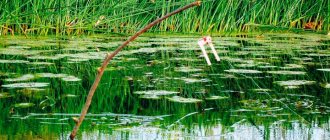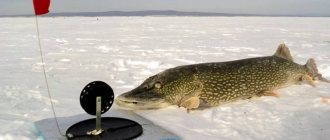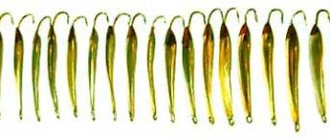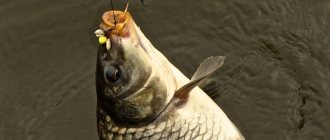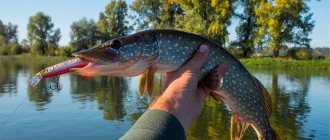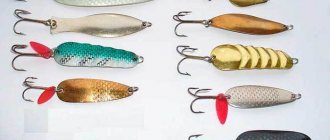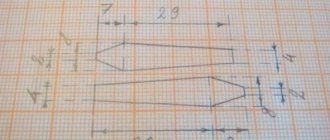What is a supply?
By delivery, as a rule, we mean an elementary or passive vent. It can be used to catch predatory fish not only in winter, but also in the summer months. The main distinguishing feature of winter gear is the absence of a bite alarm, which is usually equipped with girders.
In this regard, this tackle is used as an auxiliary one, and the main catch comes from jig tackle.
With some luck, you can catch not only the fish species already mentioned above, but also striped bass or even trout.
When a fisherman goes fishing for a certain species, he should take into account a number of points that can have a positive impact on the final result: the behavioral characteristics of this fish, what kind of life it leads, at what time it feeds, what exactly it prefers at this or that time of the year or day.
The main positive qualities of the supply are the following characteristics:
- The ability to simultaneously fish with several gears without focusing specifically on the delivery;
- This gear can be installed in one place , and direct fishing can be done in a completely different place;
- The supply is made practically from scrap materials and is not too expensive, so it is quite widespread;
- The tackle is placed under the surface of the ice , and the base is fixed on the surface of the reservoir. Due to this, pike perch and other predators living in the reservoir will easily swallow live bait. If fishing with a girder is often associated with the fact that the water in the holes freezes and becomes covered with ice, so after the first jerk the fish can release the bait and leave.
If desired, you can install a special signaling device on the tackle. To do this, install two supplies at once near each other and connect them using a fishing line, to which a small branch is attached, which will inform the fisherman about a bite.
How to catch a lot of fish?
When fishing for bream, ide
Main line 0.6 mm, leader 0.35 mm, hook number 10-12 according to the old specification. The attachment is a bunch of worms on the hook, and we fill the curlers with millet porridge bait.
And here's what you need to know: The shape of the Cheburashka collapsible jig head
It is advisable that there be a slight current in the fishing area so that the bait is gradually washed away. Check the supplies after a couple of hours.
If the weather is calm and there is a slight current, then when a fish is caught, the stand stands on its side. To do this, we staple the main line to the side of the foam.
Photos of ides caught for supply. Figure 3.
When catching predatory fish
For example, when making a stand for pike perch, we will tie a leash that can be removed from the bottom 30-50 cm above the feeder weight and attach live bait to it. If there is a pike at the fishing site, then when making a pike hook, use a leash of 0.
4 - 0.5 mm fluorocarbon is required.
Also, when fishing for pike, attach the bracket that fixes the main line so that it flies out when the pike pulls and allows the line to freely come off the set. When catching burbot, there is no need to put a top leash; use a feeder as given in the description.
I started catching bream and pike perch on the Ob Reservoir with these baits in 1975, where the use of now fashionable pin-type reversible baits is simply impossible.
You can make such tackle in literally half an hour from scrap materials; there are no special requirements for them. The only thing is that it is advisable to attach the hook to the main line through a leash - tying a new hook in the cold is an unpleasant task.
In essence, winter supplies are universal; in addition to catching pike, they can be used for carp, carp or bream. It is enough to feed the place and install the supply.
Fishing gives pleasure in its process - each of us knows this. But, besides this, we always want to get results from fishing - to catch not three perch, but a dozen kilogram pikes - what a catch! Each of us dreams of this, but not everyone can do it.
How long has it been since you had a really BIG CATCH? When was the last time you caught TEN HEAVY PIKE/CARP/BREAM?
A good catch can be achieved (and we know this) thanks to good bait. It can be prepared at home or bought in fishing stores. But stores are expensive, and to prepare bait at home, you need to spend a lot of time, and, to be fair, homemade bait does not always work well.
You know that disappointment when you buy bait or prepare it at home and only catch three or four bass? Of course it's familiar. So maybe it’s time to use a truly working product, the effectiveness of which has been proven both scientifically and in practice on the rivers and ponds of Russia?
Of course, it is better to try once than to hear a thousand times. Moreover, now is the season! A 50% discount on your order is a great bonus!
Order Fishhangri soon!
Do-it-yourself pike perch supplies
To make this tackle yourself, you need to take the following materials:
- A piece of hose made of rubber. Its length should be approximately 15 cm;
- A piece of fishing line , the diameter of which should be about 0.3-0.5 mm. It will represent the main element of the gear;
- Sliding type sinker , the mass of which should be about 40-60 grams;
- Stoppers or small pea-shaped weights;
- Tees or doubles , as well as a carbon leader. It is better not to use a metal leash in winter gear;
- A piece of thread made of nylon or thicker fishing line, due to which the supply will be attached to the corresponding support.
A small hole is punched in the rubber hose at one end; it should be located approximately three centimeters from the edge. The main fishing line and a nylon ring are threaded into it, through which the tackle will be connected to the spacer; it will be installed across the hole.
With the help of a ring, the tackle is fixed in place so that the fish that bites does not leave with it.
A small incision is made at the other end of the cut hose, the length of which should be about 2 cm. The end of the main fishing line will be pulled through it. When this work is done, a fishing line is wound around the rubber hose. Its length is selected depending on the depth of the reservoir where fishing is planned.
Usually about 15-20 meters of fishing line is enough.
A sinker is inserted into the main line and locked securely. A leash is attached to its end, the length of which should be approximately 30-40 cm. A hook is hung through the ring. The production of the supply is now complete.
All that remains is to put the bait on the hook and lower the tackle into the drilled hole, across which a strong stick is installed, which will fix the tackle and prevent it from slipping into the water. In principle, if the reservoir is located near the house, then you can disguise the gear and go into the warmth.
Equipment supplied
Any fisherman makes each of the tackles in his own way, this also applies to the supply. However, the basic composition of the device in question includes the following parts:
- Reel made of plastic or rubber tube;
- Fishing line of a certain section;
- Sinker;
- Durable leash;
- Hook (double or tee).
When fishing for pike perch using baits, it is necessary to measure the depth of the reservoir. So, the length of the main line should be about a meter longer than this, which will prevent the predator from getting entangled in snags or coastal vegetation and breaking the leash. To limit the movements of the fish, a small incision is made in the reel material, where the fishing line is installed.
As we have already said, the supply is placed under the ice; this device must be fixed on the surface. For this purpose, a reel is used; a strong cord is tied to its central part. After lowering the rig, a wooden stick is threaded through the loop and placed in the middle of the hole.

Photo 1. The simplest installation.
Catching pike perch using bait in winter

To catch a fairly large fish, you need to choose the right place where pike perch lives in the winter. Knowing the habits and habits of a given fish will also not hurt. It must be taken into account that pike perch comes out to feed either in the early morning hours or late in the evening. He spends the rest of his time in deep holes.
The stand will perform excellently if the bottom of the reservoir is sandy or rocky. The tackle is thrown close to the pits . A section of a reservoir is good for fishing if there is a fallen tree nearby or there is a snag at the bottom.
Small-sized fish with a thin body are taken as live bait; pike perch will peck perfectly on bleak or gudgeon. A good choice is a small perch, which is not too difficult to catch in winter.
Fishing techniques, where to look for pike perch at different times of the year
The gear in question is used to catch pike perch most often at any time of the year. When using a sliding sinker, the predator does not feel its weight when attacking live bait. It is known that pike perch takes its prey from the bottom up; it is very careful and throws the bait at the slightest resistance. When using a sliding sinker, the predator will not feel resistance; it will swim a certain distance and turn the fry over in its mouth, swallowing the hook. That's when it's time to hook the fish.
The principle of operation of a sliding sinker is as follows. After throwing the tackle or lowering it into the hole in winter, the load pulls the tackle to the bottom, at the same time the live bait tries to move up. While the bait is moving, the weight still lies on the bottom, without limiting the movement of the fry. The weights used for delivery must be heavy enough. Their main task is to quickly deliver the bait to the bottom. Now let’s describe the habits of pike perch at different times of the year.
Supply for pike perch in summer
With the arrival of summer heat and sunny days, bright light begins to cause some discomfort to the fish, so the pike perch goes to deep water, where the water thickness will be in the range of 4 to 7 meters.
In the morning or evening hours - before and after sunset, pike perch goes to shallow water, passing through the area of flooded trees and other shelters. This is where the largest specimens of fish pass.
Sometimes it happens that a predatory fish stands at a relatively shallow depth - about 3 meters . This happens if the area of the reservoir is located in the shade, for example, near trees or near stones. Large pike perch are well caught in summer in lakes; the fish there grow to very large sizes.
However, in such reservoirs it behaves as carefully as possible and prefers to live at great depths.
Equipment for summer vents
The main thing is to make a feeder weight.
To do this you will need lead, a large metal curler, and an iron shoe polish lid. Place the curlers in the cream lid and fill them with molten lead. After the lead has cooled, drill a hole in the middle of the filled edge of the curler in the lead for the fishing line. The feeder weight is ready. Photo of the delivery. Picture 1.
The supply consists of the following main parts:
- Bracket
- Feeder load
- Delivery
- Hook
- Limiter
Next, we will cut out a 90 by 90 mm square from foam plastic 40-50 mm thick, this will be the delivery. Half of one side of the delivery diagonally can be painted over with red paint.
We attach the fishing line to the supply and wind it around the supply with an excess of the fishing depth. The very same length of the fishing line can be set at the fishing site with a bracket tied to the stand in the hole through its center and stuck on the side into the foam. We measure the depth by unwinding the fishing line from the supply, add a couple of meters and fasten the main fishing line with a bracket.
Image of pikes caught on hooks. Figure 2
Assembling the supply. We pass the end of the wound fishing line through the curler on top of the hole in the lead and tie a limiter (carabiner or lead sinker) to it, and tie a leash with a hook to the carabiner.
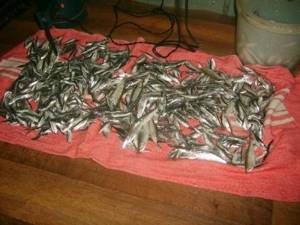
If the reservoir is unfamiliar and the topology of the bottom is unknown, then you can make a universal supply. To do this, loops begin to be knitted every meter starting from the sinker, and the float-buoy is attached to one of these loops. When the anchor is set and the buoy is attached, it becomes clear which loops the leashes with hooks need to be attached to. This makes it easier to set up in an unfamiliar place and significantly saves time.
To catch a fairly large fish, you need to choose the right place where pike perch lives in the winter. Knowing the habits and habits of a given fish will also not hurt. It must be taken into account that pike perch comes out to feed either in the early morning hours or late in the evening. He spends the rest of his time in deep holes.
The stand will perform excellently if the bottom of the reservoir is sandy or rocky. The tackle is thrown close to the pits. A section of a reservoir is good for fishing if there is a fallen tree nearby or there is a snag at the bottom.
Small-sized fish with a thin body are taken as live bait; pike perch will peck perfectly on bleak or gudgeon. A good choice is a small perch, which is not too difficult to catch in winter.
With the arrival of summer heat and sunny days, bright light begins to cause some discomfort to the fish, so the pike perch goes to deep water, where the water thickness will be in the range of 4 to 7 meters.
In the morning or evening hours - before and after sunset, pike perch goes to shallow water, passing through the area of flooded trees and other shelters. This is where the largest specimens of fish pass.
Sometimes it happens that a predatory fish stands at a relatively shallow depth - about 3 meters. This happens if the area of the reservoir is located in the shade, for example, near trees or near stones. Large pike perch are well caught in summer in lakes; the fish there grow to very large sizes.
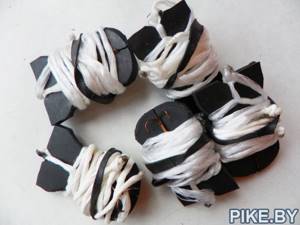
However, in such reservoirs it behaves as carefully as possible and prefers to live at great depths.
In order for the fishing to be most successful, it is necessary to properly attach the sprat. Some fishermen try to choose thicker and larger live bait, but regularly practicing fishermen know that fish more than five centimeters in length are not sufficiently swallowed by pike perch.
Fishing for pike on a set cannot rightfully be called interesting and exciting. Outwardly, the process of such fishing looks calm and relatively boring. However, it has its advantages. Fishing does not require constant supervision. It is enough to check the supply once a day or, say, once every three days.
https://www.youtube.com/watch?v=CrVxixq-BLk
If the fish is caught, it is taken back and re-equipped. Another advantage is the efficiency of this method. You can take a fishing rod and five or ten hooks with you on a fishing trip. Small fish caught on a fishing rod can be used as bait. Having equipped the existing supplies. Can you fish with a fishing rod, occasionally checking to see if a fish has been caught?
And here's what you need to know: Fishing for pike perch with sprat in winter, what gear to take and where to catch
How to make a pike stand with your own hands?
The supply is an old tackle for pike, but even today it is quite catchy. They catch pike with bait in the summer, various predatory fish in the winter, and large perch take small baitfish in the early spring. A do-it-yourself pike rig does not require any special expenses, just a fishing line, a sinker, a leash, a hook and improvised materials.
Postavushka (under-ice vent)
- Compact;
- easy to use;
- the line falls smoothly and evenly.
We read: Summer supplies (zherlitsy) for pike.
The gear does not require constant supervision; if it is stolen, you won’t mind. It is especially convenient to catch with baits in winter; leave it for a long time and check it every 2-3 days.
In the middle of winter, the fish are “sluggish”; you can’t expect bites in a day on ordinary girders. The pike bite is most common in the early morning or late evening.
While you’re catching live bait and setting up your bait, it’s dusk and it’s time to leave. And the supply, which has stood for a couple of days, is often with pike.
Live bait and caught fish live for a long time in cold water, but the bait lowered under the ice and covered with snow is not visible to curious fishermen. Even accidentally found under-ice vents cannot be checked without an ice pick or special device.
For your own convenience, a mark is left next to the under-ice vent. Five steps from the working hole, a twig or branch is frozen.
The hole itself is marked with a little noticeable snow bump.
Ten supplies placed in promising places will allow you to be with the fish. According to the first/last ice, such places are the coastal zone, coastal slopes in depth, the mouths of flowing rivers and streams. In the middle of winter, deep-sea edges and other depth changes are added. Supplying tackle for pike is self-cutting, the equipment must be correct. From my own practice of catching fish on a stand.
Do-it-yourself pike rack
The process of making this gear is quite simple and anyone can handle it. To do this, you need to prepare all the materials in advance.
What you will need
In addition to pike, they also catch burbot. Catfish, pike perch and carp also actively bite on this tackle. The most important thing here is to know their habitats and feeding areas. This way you can catch pike perch early in the morning or late in the evening. If you want to catch catfish, then you should be patient, as this fish is very careful. Yes, and here you will have to take stronger gear, and choose a thicker fishing line.
The gear is quite simple, so each fisherman can make several deliveries at once. For the base or reel, it is recommended to take a 20 centimeter piece of rubber hose or plastic pipe, the length of the product is from 3 to 4 centimeters.
At the next stage of work, it is necessary to wind a fishing line (about 7-8 meters) onto the reel, the cross-section of the thread is 3-5 millimeters. Next, install a sliding weight and a leash up to 1 meter long.
At the final stage, a double or triple hook is tied. That's all, your supply is ready for use.
With the arrival of summer, most reservoirs begin to be overgrown with aquatic and coastal vegetation. In addition, there are other underwater surprises that limit the use of spinning rods. As a rule, pike are found in hard-to-reach places, so the problem can be solved with the help of a girder.
For those who regularly catch pike with girders in winter, it will not be difficult to convert winter gear to summer gear. Unfortunately, there are fishermen who do not have information regarding the construction of girders.
Basically, the vent is made from simple and affordable materials, sometimes unsuitable for other purposes. If you have to fish on a river, then you need to think in advance about how the tackle will be attached.
To arrange a summer barn you will need:
- The place where the pier will be attached to the shore. This can be a specially prepared stick or coastal vegetation can be used: trees, bushes or branches of overhanging trees.
- As the basis of the girder, it is possible to use elements prepared at home or elements found on the shore of a reservoir. For example, you can easily find a wooden flyer or a plastic bottle. For the initial clamping of the fishing line, cuts in the wood or rubber rings are used, which securely hold the fishing line until the bite.
- A fishing line with a thickness of 0.4-0.6 mm and a length of 15-20 m is suitable as the main fishing line. It is not recommended to install longer sections of fishing line, as the pike can get caught in snags. Using a very short length will not allow the pike to swallow the bait.
- Sliding weight with swivel. The weight of the cargo is selected depending on various factors, such as the size of the bait and the presence of a current.
- The swivel is needed to connect the leash. Especially needed when there is a current.
- Retaining rings will limit the movement of the load along the fishing line.
- A metal leash is required. Its length is 30 cm.
- Any type of hooks can be installed, both single, double and triple. It is possible to install two leashes with hooks, but no more, so as not to complicate the fishing process.
And here's what you need to know: Fishing with a hook
If you have a boat, then installing the vent in the right place will not be difficult. It is extremely difficult to install summer girders from the shore, without a boat, especially if there are coastal thickets. Although this is not a problem if you take off your clothes, especially since it’s summer outside and not cold winter.
As mentioned above, making such gear yourself is not at all difficult. Making your own gear allows you to take into account all the fishing subtleties and fishing conditions. For novice fishermen, this is not entirely clear, since they have not yet mastered the intricacies of fishing.
Classic zherlitsa - flyer
This is the simplest design, the principle of operation of which has remained unchanged for many centuries. Such gear is successfully used in our time, since it can be made directly near a reservoir, with minimal waste of time and components.
The zherlitsa is a typical pike tackle, since the pike actively reacts to live bait, which is its nutritional component for every day. This gear catches pike where other gear is simply useless.
Pike loves to be in places where there is a certain shelter that can protect it from a threat or serve as a kind of ambush. In such places, it is simply not possible to do without hooks if you use a spinning rod.
Pike perch on sprat, supplies
In order for the fishing to be most successful, it is necessary to properly attach the sprat. Some fishermen try to choose thicker and larger live bait, but regularly practicing fishermen know that fish more than five centimeters in length are not sufficiently swallowed by pike perch.
It happens that a predator does not try to swallow such bait at all: he bites off a piece of meat from it and swims on. If fishing will be done in a standing reservoir, then it is best to plant the sprat closer to the tail . This is due to the way the pike perch swallows the fish - it does it from the head.
When hooking, this method of setting the bait allows the hook to better catch on the upper jaw.
When fishing in the current, the sprat is pierced by the upper fin or across the body, so it will glide much better in the water column.


